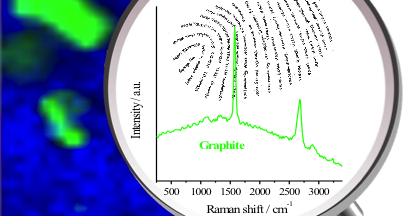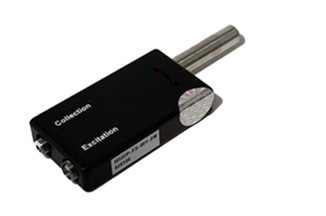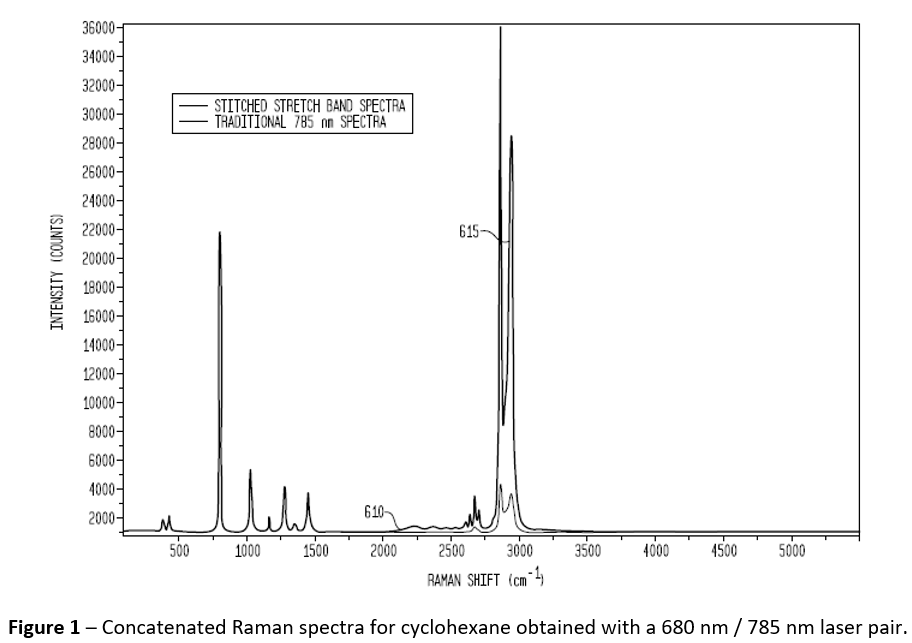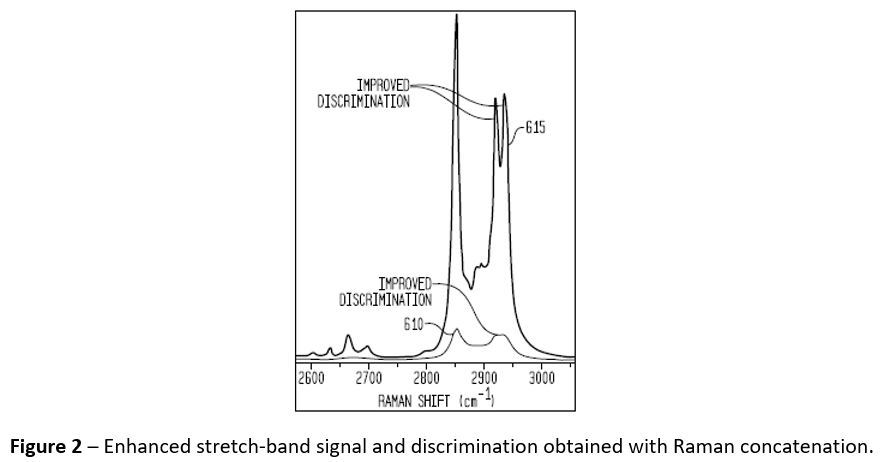
Raman Spectroscopy has become increasingly popular in recent years. With more demand for this application, some companies have strived to make advancements to the associated technology and hardware, in an effort to provide better results, more throughput, increased flexibility, and a reduction in total footprint of these devices. In this article, we are going to highlight a newly released, advanced, and versatile Raman probe, providing some key features and improvements, designed to get you even better, faster results for any Raman Spectroscopy application.

The most exciting, unique feature of this Raman probe is the dual-wavelength concatenation capability. There are other, standard configurations already on the market that offer two wavelengths (say 532 & 785nm dual-band). However, these devices require two separate spectrometers. Basically, they are just switching between the two bands, utilizing each wavelength for different samples with unique fluorescent characteristics. Now, this new design allows you to interrogate the whole band (fingerprint and stretch region) with a single spectrometer. No more switching.
This dual-wavelength approach is greatly beneficial for process Raman applications. Raman spectroscopy can be used in various industrial process settings to enhance efficiencies and better understand the process. Raman ensures product quality and process stability by providing real-time material composition data to advanced process control (APC) systems. This critical, real-time data empowers you to make knowledgeable, on-the-fly adjustments to your process, helping to avoid unnecessary, costly downtime and rejected material lots. We hope to expand on this further, once studies have had a chance to be published, regarding one application quantifying the fat content in different milk products (skim/whole/heavy cream) with a 680nm/785nm probe, and one looking at biodiesel fuels to observe the differences between different mixtures with an 860nm/1064nm probe.

There are many ‘process Raman applications’ that require greater quantitative information, and this device provides excellent data in the stretch region, facilitating these greater requirements. If your application has an important peak out in the stretch band, this new Raman probe design provides approximately a factor of 10 higher signal to noise ratio over traditional devices. For more details on the dual-wavelength and concatenation benefits, check out this previously released blog, “How Does Concatenation Enhance Raman Spectroscopy?“

This Raman probe is designed for both single and dual excitation wavelengths. Two different laser excitation sources, incident upon the sample one at a time, collect the fingerprint and stretch portion of the Raman spectra, respectively. Single-wavelength configurations simply interrogate and collect the fingerprint Raman band (0-2000cm-1), with wavelength options including 405, 532, 638, 785, 808, 830, and 1064nm. Dual-wavelength configurations are available in 680/785nm, 735/830nm, and 860/1064nm options for interrogating both the fingerprint (0-2000cm-1) and stretch (2000-4000cm-1) regions with a single spectrometer. Once the desired wavelengths are chosen, the probe merely requires a particular set of matching, off-the-shelf filters to be installed. Both single and dual-wavelength designs share the same, identical housing. The only difference between the two designs is the second laser source and the particular filter packs installed at the factory. Custom wavelengths can be requested, and we will see what standard filters are available to match that wavelength. If you need some particularly special custom wavelength, we still may be able to help, we would just need to source custom filters, which will add to the overall cost. We offer many Laser Diodes and Laser Diode Modules that are compatible with these Raman Probes, including a newly release Homogenized Laser Diode, which you can read about HERE in this blog, or check out these product pages HERE.
Homogenized Laser Diodes for Raman!
Laser Diode Modules for Raman!
The filter packs are just one of the exciting new configurable enhancements on these Raman probes. The filters are customized to work for both wavelength bands in the concatenation system, and they will work with each of the single-wavelength bands for the fingerprint region. These filters allow transmission of the excitation beam from the excitation port (laser source) to the sample and transmit the reflected Raman light to the collection port (spectrometer). Another exciting enhancement in this probe is the novel shutter design, comprised of Teflon, which provides a unique benefit. When the shutter is closed, one can measure the Teflon spectrum, providing an imbedded standard inside the probe housing for constant monitoring and spectrometer calibration.
Depending on specific user requirements, we can configure the probe tip for both laboratory and immersion applications, and we can offer different focal length lenses to be installed at the probe tip to adjust the working distance of the probe. Shorter working distances have an inherently higher numerical aperture (NA), while longer distance lenses have a smaller NA. These lenses are interchangeable, allowing the user to simply swap out a lens for expanded application capabilities. Excitation and collection optics can also be configured for optimizing the NA. We can also configure the excitation and collection optics for optimizing the NA on the input and output ports. We use different, interchangeable optics: typically for the input side, we can optimize for different excitation fibers used by the customer, and for the output side, we can optimize the NA for different f# spectrometers that may be used. There are different fibers and NA collection optics we can use to optimize the Raman signal paths. Our Raman Probe will work with basically any spectrometer on the market, and since each spectrometer is a little different, simply relying on the f# is not sufficient. Typically we will discuss these details with the customer, find out which spectrometer they are using and then we can make a recommendation on how to best optimize the signal collection for their specific application. So, we start with a standard design, and configure everything from there, ensuring you get exactly what you need to meet your requirements.
This Raman probe design allows for removable collection and excitation fibers, enabling simpler optimization and repair. Most of the time, its easier to simply ship a new fiber, replacing a broken one at your facility, than it is to ship the entire unit back for a mere fiber replacement. This design feature also allows you to try out multiple different fiber diameters and NAs to try to optimize the system. So, while we will happily recommend the best fiber options to match your application, you’re always able to try a different combination, especially if you want to modify or completely change your application at any point. Fibers are not typically provided with the standard purchase of a Raman probe. However, we will always help by recommending your best options, and can source the fibers upon request. This probe can accept FC/PC or SMA fiber connectors.
Various customers will have different cut-on wavenumber requirements. This is where the spectrometer will start recording the Raman spectra. The closer the cut-on wavenumber is to zero, the more complicated and costly the filters become. Long-pass filters have different cut-on numbers, and we can configure the probe for the value you need, or work with our vendors to adjust available options. Finally, we are able to provide an integrated Raman probe with the laser integrated into the probe housing. Just give us a call so we can discuss your needs!
Talk to a knowledgeable Product Manager today by Contacting Us here, or by calling us at 636.272.7227!

 SHIPS TODAY
SHIPS TODAY 